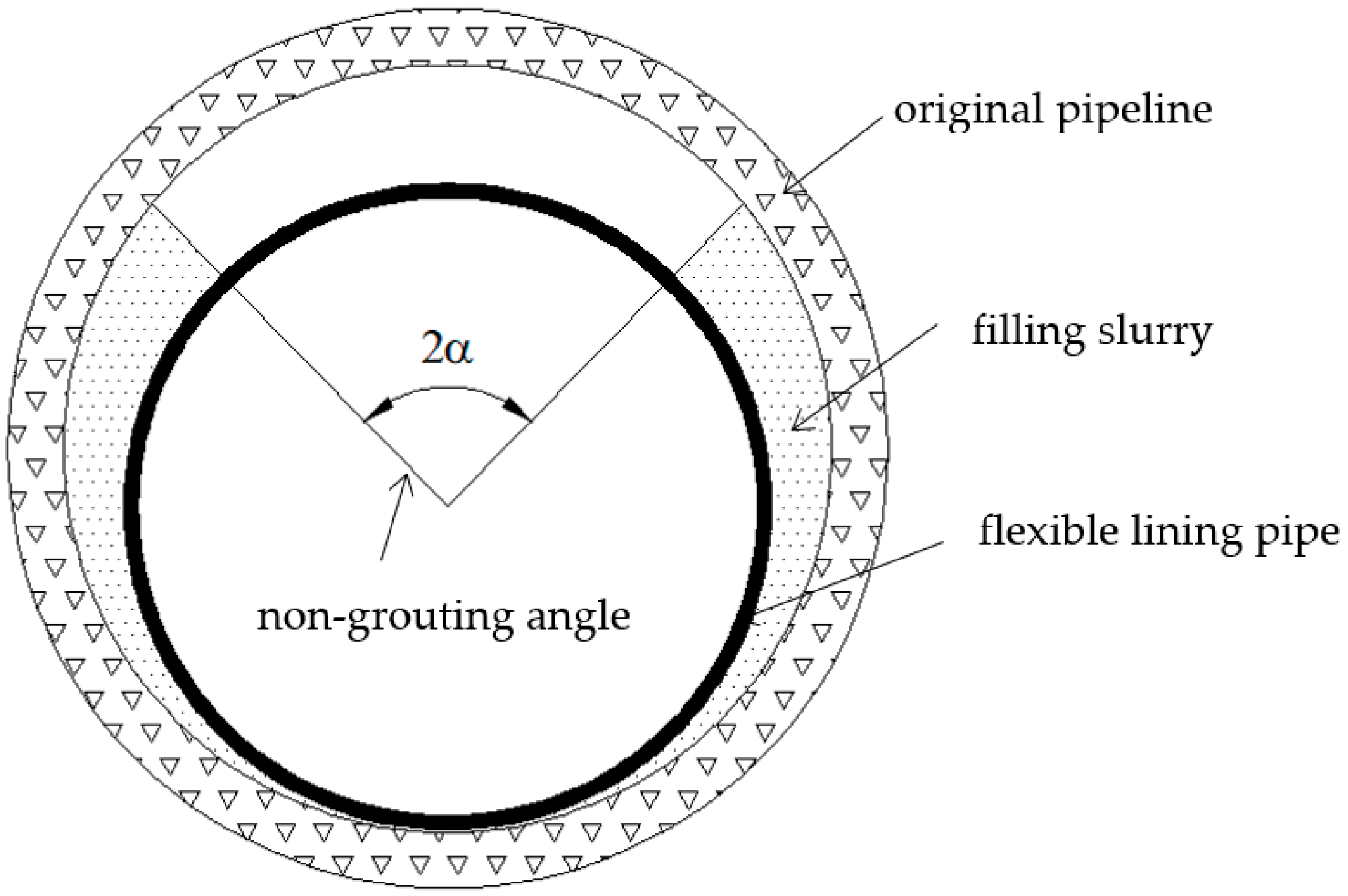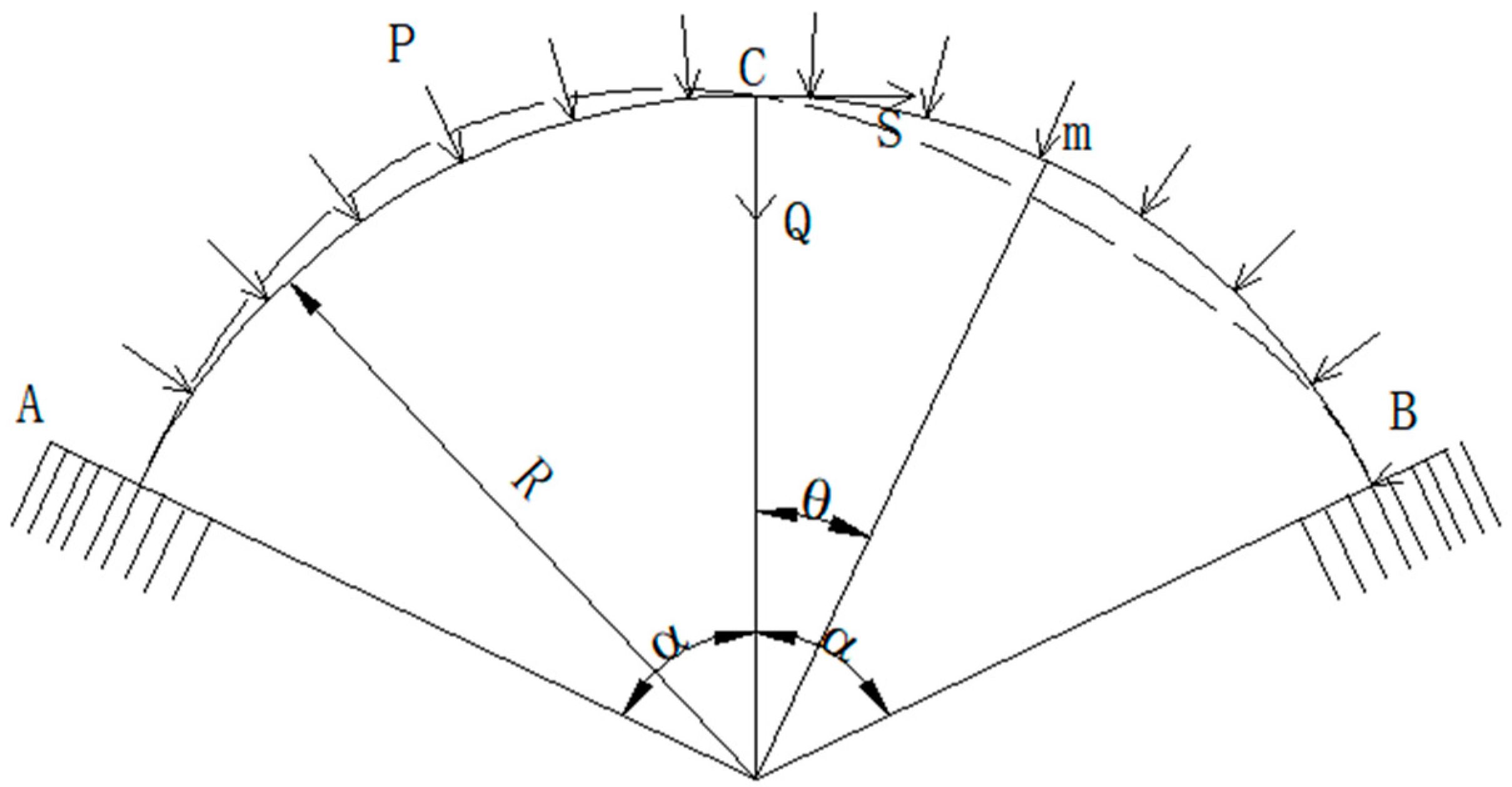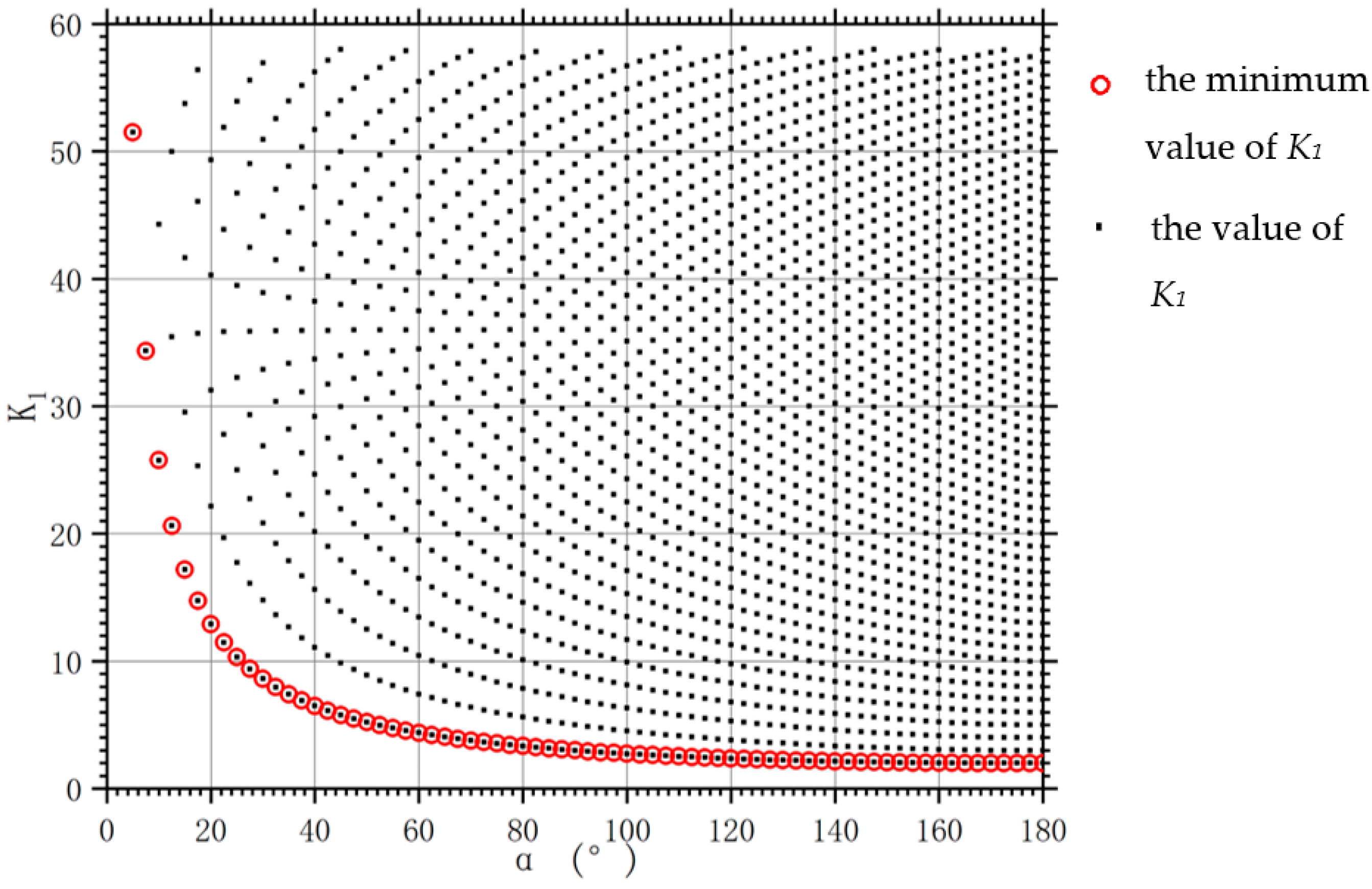Theoretical Study on Design of Composite Lining Structure with Rigid–Flexible Combination for Trenchless Pipeline Rehabilitation
Abstract
:1. Review on Design Theory of Lining for Trenchless Pipeline Rehabilitation
2. Theoretical Basis of Rigid–Flexible Composite Lining Structure Design
3. Design Formula of Rigid–Flexible Composite Lining Structure in ASTM Standard
4. Solution of K1 Value
5. Modification of Structural Design Formula of Rigid–Flexible Composite Lining in ASTM Standard
6. Conclusions
Author Contributions
Funding
Institutional Review Board Statement
Informed Consent Statement
Data Availability Statement
Conflicts of Interest
References
- Ma, B. Non-Excavation Pipeline Repair and Update Technology; People’s Transportation Press: Beijing, China, 2014. [Google Scholar]
- Timoshenko, S.P.; Gere, J.M. Theory of Elastic Stability; Courier Corporation: Chelmsford, MA, USA, 2009. [Google Scholar]
- Boot, J.C.; Toropova, I.L.; Javadi, A.A. Predicting the creep lives of thin-walled cylindrical polymeric pipe linings subject to external pressure. Int. J. Solids Struct. 2003, 40, 7299–7314. [Google Scholar] [CrossRef]
- Boot, J.C.; Javadi, A.A.; Toropova, I.L. The structural performance of polymeric linings for nominally cylindrical gravity pipes. Thin-Walled Struct. 2004, 42, 1139–1160. [Google Scholar] [CrossRef]
- Boot, J.C.; Gumbel, J.E. Research requirements in support of the renovation of pressure and non-pressure pipes. Tunn. Undergr. Space Technol. 2007, 22, 515–523. [Google Scholar] [CrossRef]
- Li, Z.; Wang, L.; Guo, Z.; Shu, H. Elastic buckling of cylindrical pipe linings with variable thickness encased in rigid host pipes. Thin-Walled Struct. 2012, 51, 10–19. [Google Scholar] [CrossRef]
- Rueda, F.; Marquez, A.; Otegui, J.L.; Frontini, P.M. Buckling collapse of HDPE liners: Experimental set-up and FEM simulations. Thin-Walled Struct. 2016, 109, 103–112. [Google Scholar] [CrossRef]
- Vasilikis, D.; Karamanos, S.A. Mechanical behavior and wrinkling of lined pipes. Int. J. Solids Struct. 2012, 49, 3432–3446. [Google Scholar] [CrossRef] [Green Version]
- Vasilikis, D.; Karamanos, S.A. Stability of confined thin-walled steel cylinders under external pressure. Int. J. Mech. Sci. 2009, 51, 21–32. [Google Scholar] [CrossRef]
- Vasilikis, D.; Karamanos, S.A. Mechanics of Confined Thin-Walled Cylinders Subjected to External Pressure. Appl. Mech. Rev. 2013, 65, 1001. [Google Scholar] [CrossRef]
- Lu, C.; Ariaratnam, S.T.; Yan, X.; Ma, B.; Zhao, Y.; Xiang, W. Buckling Behavior of Thin-Walled Stainless-Steel Lining Wrapped in Water-Supply Pipe under Negative Pressure. Appl. Sci. 2021, 11, 6781. [Google Scholar] [CrossRef]
- ASTM F 1947; Standard Practice for Installation of Folded Poly (Vinyl Chloride) (PVC) Pipe into Existing Sewer and Conduits. ASTM Committee F17. American Society for Testing and Materials: West Conshohocken, PA, USA, 2011.
- ASTM F 1867; Standard Practice for Installation of Folded/Formed Poly (Vinyl Chloride) Pipe Type A for Existing Sewer and Conduit Rehabilitation. ASTM Committee F17. American Society for Testing and Materials: West Conshohocken, PA, USA, 2012.
- ASTM F 1606; Standard Practice for Rehabilitation of Existing Sewers and Conduits with Deformed Polyethylene (PE) Liner. ASTM Committee F17. American Society for Testing and Materials: West Conshohocken, PA, USA, 2014.
- ASTM F 1216; Standard Practice for Rehabilitation of Existing Pipelines and Conduits by the Inversion and Curing of a Resin-Impregnated Tube. ASTM Committee F17. American Society for Testing and Materials: West Conshohocken, PA, USA, 2016.
- ASTM F 1743; Standard Practice for Rehabilitation of Existing Pipelines and Conduits by the in-Place Installation of Cured-in-Place Thermosetting Resin Pipe (CIPP). ASTM Committee F17. American Society for Testing and Materials: West Conshohocken, PA, USA, 2017.
- ASTM F 2019; Standard Practice for Rehabilitation of Existing Pipelines and Conduits by the Pulled in Place Installation of Glass Reinforced Plastic (GRP) Cured-in-Place Thermosetting Resin Pipe (CIPP). ASTM Committee F17. American Society for Testing and Materials: West Conshohocken, PA, USA, 2011.
- Kong, Y. Study and Application of Cast In-Situ Method for Pipeline and Manhole Trenchless Rehabilitation; China University of Geosciences: Wuhan, China, 2017. [Google Scholar]
- Zhang, H. Theoretical and Experimental Study on Structural Performance of the Sprayed-on Cement Mortor Liners Rehabilitaing Precast Concrete Drainage Pipe; China University of Geosciences: Wuhan, China, 2019. [Google Scholar]
- Zhao, Y.; Ma, B.; Ariaratnam, S.T.; Zeng, C.; Yan, X.; Wang, F.; Wang, T.; Zhu, Z.; He, C.; Shi, G.; et al. Structural Performance of Damaged Rigid Pipe Rehabilitated by Centrifugal Spray on Mortar Liner. Tunn. Undergr. Space Technol. 2021, 116, 104117. [Google Scholar] [CrossRef]
- Becerril García, D.; Moore, I.D. Performance of deteriorated corrugated steel culverts rehabilitated with sprayed-on cementitious liners subjected to surface loads. Tunn. Undergr. Space Technol. 2015, 47, 222–232. [Google Scholar] [CrossRef]
- Moore, I.D.; García, D.B. Ultimate Strength Testing of Two Deteriorated Metal Culverts Repaired with Spray-On Cementitious Liners. Transp. Res. Rec. J. Transp. Res. Board. 2015, 2522, 139–147. [Google Scholar] [CrossRef]
- Riahi, E.; Yu, X.; Najafi, M.; Sever, V.F. D-Load Strength of Concrete Pipes with Epoxy Linings. J. Pipeline Syst. Eng. Pract. 2019, 10, 04019030. [Google Scholar] [CrossRef]
- Simpson, B.; Hoult, N.A.; Moore, I.D. Rehabilitated reinforced concrete culvert performance under surface loading. Tunn. Undergr. Space Technol. 2017, 69, 52–63. [Google Scholar] [CrossRef]
- Wang, J.H.; Koizumi, A.; Yuan, D.J. Theoretical and numerical analyses of hydrostatic buckling of a noncircular composite liner with arched invert. Thin-Walled Struct. 2016, 102, 148–157. [Google Scholar] [CrossRef]
- ASTM F 1741; Standard Practice for Installation of Machine Spiral Wound Poly (Vinyl Chloride) (PVC) Liner Pipe for Rehabilitation of Existing Sewers and Conduits. ASTM Committee F17. American Society for Testing and Materials: West Conshohocken, PA, USA, 2016.
- Wang, L. Technical Specification for Trenchless Rehabilitation and Renewal of Urban Sewer Pipeline; CJJ/T210; China Construction Industry Press: Beijing, China, 2014. [Google Scholar]
- Zhao, W.; Grant, L. liner long-term performance life prediction using critical buckling strain. In Proceedings of the North American Society for Trenchless Technology 2008 No-Dig Conference & Exhibition, Dallas, TX, USA, 27 April–2 May 2008; p. A-1-04. [Google Scholar]
- Li, Q.; Wang, N.; Li, D. Numerical Analysis; Tsinghua University Press: Beijing, China, 2008. [Google Scholar]
- Wu, C.; Wang, T.; Li, J.; Li, J.; Ge, W. Safety Statistics; Mechanical Industry Press: Beijing, China, 2014. [Google Scholar]





| α (°) | K1 | α (°) | K1 | α (°) | K1 |
|---|---|---|---|---|---|
| 5 | 51.50 | 65 | 4.05 | 125 | 2.30 |
| 7.5 | 34.34 | 67.5 | 3.91 | 127.5 | 2.26 |
| 10 | 25.76 | 70 | 3.78 | 130 | 2.24 |
| 12.5 | 20.61 | 72.5 | 3.66 | 132.5 | 2.21 |
| 15 | 17.18 | 75 | 3.54 | 135 | 2.18 |
| 17.5 | 14.73 | 77.5 | 3.44 | 137.5 | 2.16 |
| 20 | 12.90 | 80 | 3.34 | 140 | 2.14 |
| 22.5 | 11.47 | 82.5 | 3.24 | 142.5 | 2.12 |
| 25 | 10.33 | 85 | 3.16 | 145 | 2.10 |
| 27.5 | 9.40 | 87.5 | 3.08 | 147.5 | 2.08 |
| 30 | 8.62 | 90 | 3.00 | 150 | 2.07 |
| 32.5 | 7.96 | 92.5 | 2.93 | 152.5 | 2.05 |
| 35 | 7.40 | 95 | 2.86 | 155 | 2.04 |
| 37.5 | 6.92 | 97.5 | 2.80 | 157.5 | 2.03 |
| 40 | 6.49 | 100 | 2.74 | 160 | 2.02 |
| 42.5 | 6.11 | 102.5 | 2.68 | 162.5 | 2.02 |
| 45 | 5.78 | 105 | 2.63 | 165 | 2.01 |
| 47.5 | 5.48 | 107.5 | 2.58 | 167.5 | 2.01 |
| 50 | 5.22 | 110 | 2.53 | 170 | 2.00 |
| 52.5 | 4.98 | 112.5 | 2.48 | 172.5 | 2.00 |
| 55 | 4.76 | 115 | 2.44 | 175 | 2.00 |
| 57.5 | 4.56 | 117.5 | 2.40 | 177.5 | 2.00 |
| 60 | 4.37 | 120 | 2.36 | 180 | 2.00 |
| 62.5 | 4.21 | 122.5 | 2.33 |
Publisher’s Note: MDPI stays neutral with regard to jurisdictional claims in published maps and institutional affiliations. |
© 2022 by the authors. Licensee MDPI, Basel, Switzerland. This article is an open access article distributed under the terms and conditions of the Creative Commons Attribution (CC BY) license (https://creativecommons.org/licenses/by/4.0/).
Share and Cite
Ti, Z.; Wang, F.; Zhao, Y.; Ma, B.; Zeng, C.; Liao, B. Theoretical Study on Design of Composite Lining Structure with Rigid–Flexible Combination for Trenchless Pipeline Rehabilitation. Appl. Sci. 2022, 12, 5374. https://doi.org/10.3390/app12115374
Ti Z, Wang F, Zhao Y, Ma B, Zeng C, Liao B. Theoretical Study on Design of Composite Lining Structure with Rigid–Flexible Combination for Trenchless Pipeline Rehabilitation. Applied Sciences. 2022; 12(11):5374. https://doi.org/10.3390/app12115374
Chicago/Turabian StyleTi, Zhongsen, Fuzhi Wang, Yahong Zhao, Baosong Ma, Cong Zeng, and Baoyong Liao. 2022. "Theoretical Study on Design of Composite Lining Structure with Rigid–Flexible Combination for Trenchless Pipeline Rehabilitation" Applied Sciences 12, no. 11: 5374. https://doi.org/10.3390/app12115374







